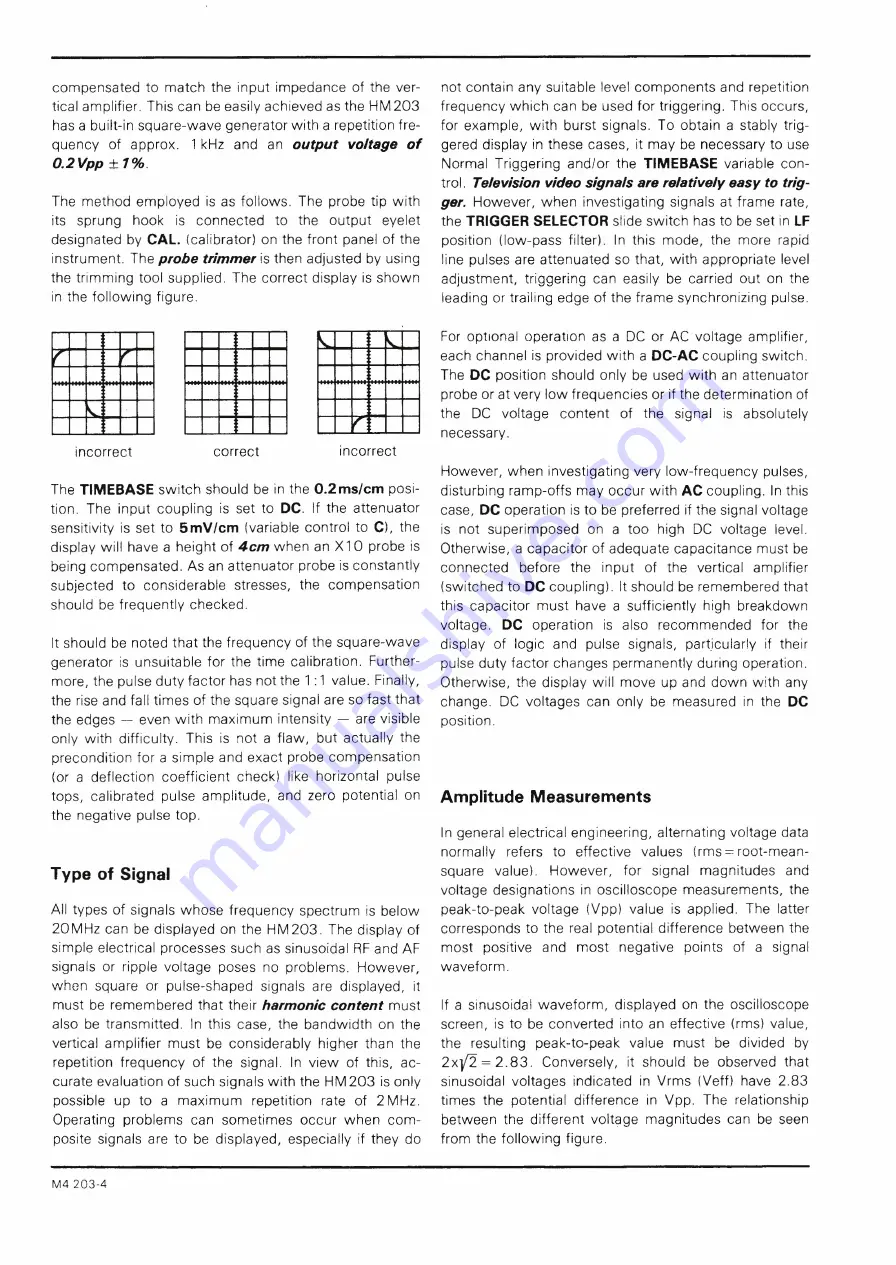
compensated to match the input impedance of the ver
tical amplifier. This can be easily achieved as the HM203
has a built-in square-wave generator with a repetition fre
quency of approx. 1 kHz and an
output voltage of
0 .2 Vpp ± 1 %
The method employed is as follows. The probe tip with
its sprung hook is connected to the output eyelet
designated by
CAL.
(calibrator) on the front panel of the
instrument. The
probe trimmer
is then adjusted by using
the trimming tool supplied. The correct display is shown
in the following figure.
incorrect
correct
incorrect
The
TIMEBASE
switch should be in the
0.2ms/cm
posi
tion. The input coupling is set to
DC.
If the attenuator
sensitivity is set to
5mV/cm
(variable control to
C),
the
display will have a height of
4cm
when an X I 0 probe is
being compensated. As an attenuator probe is constantly
subjected to considerable stresses, the compensation
should be frequently checked.
It should be noted that the frequency of the square-wave
generator is unsuitable for the time calibration. Further
more, the pulse duty factor has not the 1:1 value. Finally,
the rise and fall times of the square signal are so fast that
the edges — even with maximum intensity — are visible
only with difficulty. This is not a flaw, but actually the
precondition for a simple and exact probe compensation
(or a deflection coefficient check) like horizontal pulse
tops, calibrated pulse amplitude, and zero potential on
the negative pulse top.
Type of Signal
All types of signals whose frequency spectrum is below
20MHz can be displayed on the HM203. The display of
simple electrical processes such as sinusoidal RF and AF
signals or ripple voltage poses no problems. However,
when square or pulse-shaped signals are displayed, it
must be remembered that their
harmonic content
must
also be transmitted. In this case, the bandwidth on the
vertical amplifier must be considerably higher than the
repetition frequency of the signal. In view of this, ac
curate evaluation of such signals with the HM203 is only
possible up to a maximum repetition rate of 2 MHz.
Operating problems can sometimes occur when com
posite signals are to be displayed, especially if they do
not contain any suitable level components and repetition
frequency which can be used for triggering. This occurs,
for example, with burst signals. To obtain a stably trig
gered display in these cases, it may be necessary to use
Normal Triggering and/or the
TIMEBASE
variable con
trol.
Television video signals are relatively easy to trig
ger.
However, when investigating signals at frame rate,
the
TRIGGER SELECTOR
slide switch has to be set in
LF
position (low-pass filter). In this mode, the more rapid
line pulses are attenuated so that, with appropriate level
adjustment, triggering can easily be carried out on the
leading or trailing edge of the frame synchronizing pulse.
For optional operation as a DC or AC voltage amplifier,
each channel is provided with a
DC-AC
coupling switch.
The
DC
position should only be used with an attenuator
probe or at very low frequencies or if the determination of
the DC voltage content of the signal is absolutely
necessary.
However, when investigating very low-frequency pulses,
disturbing ramp-offs may occur with
AC
coupling. In this
case,
DC
operation is to be preferred if the signal voltage
is not superimposed on a too high DC voltage level.
Otherwise, a capacitor of adequate capacitance must be
connected before the input of the vertical amplifier
(switched to
DC
coupling). It should be remembered that
this capacitor must have a sufficiently high breakdown
voltage.
DC
operation is also recommended for the
display of logic and pulse signals, particularly if their
pulse duty factor changes permanently during operation.
Otherwise, the display will move up and down with any
change. DC voltages can only be measured in the
DC
position.
Amplitude Measurements
In general electrical engineering, alternating voltage data
normally refers to effective values (rms = root-mean-
square value). However, for signal magnitudes and
voltage designations in oscilloscope measurements, the
peak-to-peak voltage (Vpp) value is applied. The latter
corresponds to the real potential difference between the
most positive and most negative points of a signal
waveform.
If a sinusoidal waveform, displayed on the oscilloscope
screen, is to be converted into an effective (rms) value,
the resulting peak-to-peak value must be divided by
2x|/2 = 2.83. Conversely, it should be observed that
sinusoidal voltages indicated in Vrms (Veff) have 2.83
times the potential difference in Vpp. The relationship
between the different voltage magnitudes can be seen
from the following figure.
S»
r
r
\
M4 203-4









































